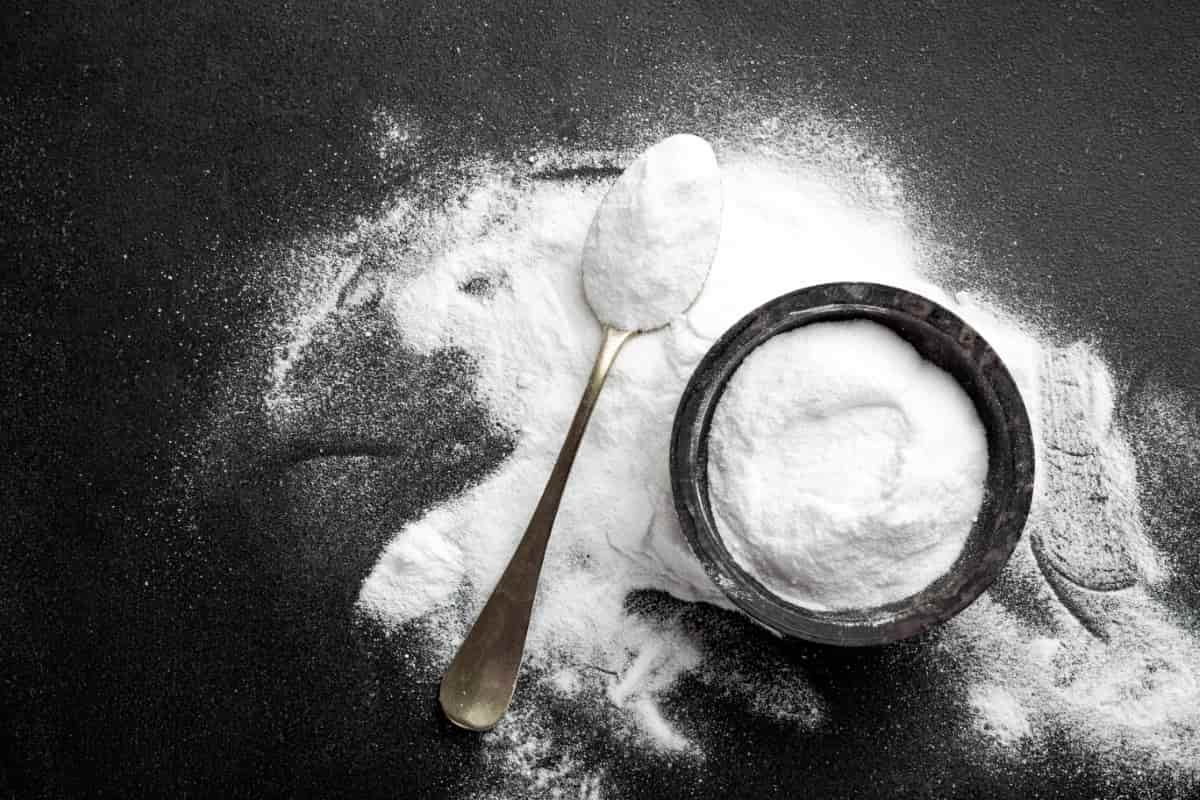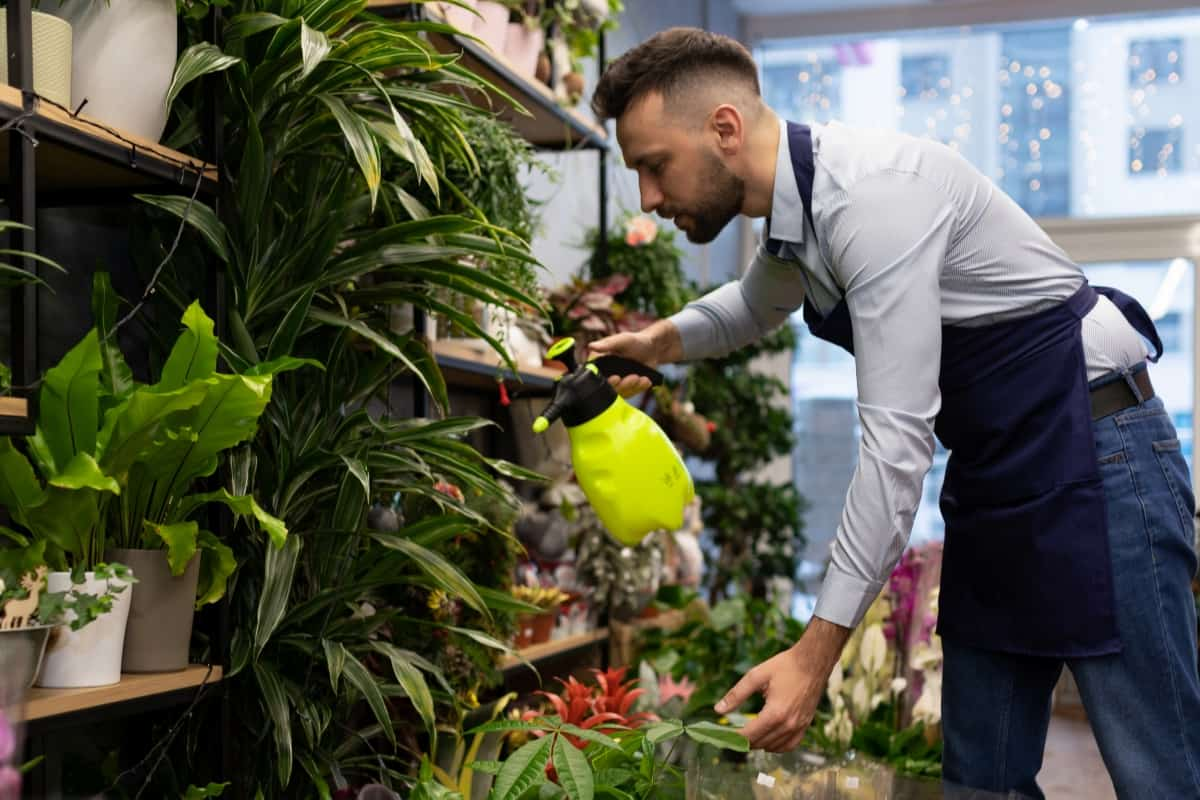Most kitchens contain baking soda as a staple ingredient. Sodium bicarbonate, also named bicarbonate of soda or bicarb, is a useful leavening agent for baking. Baking soda contains only one ingredient – sodium bicarbonate. That ingredient has four elements: carbon, sodium, hydrogen, and oxygen. There are numerous uses for baking soda in the garden, from killing weeds to controlling insects and pests.

Houseplants can benefit from baking soda as well. A person who says, “I burnt my plants with baking soda,” probably used too much. If you are concerned about baking soda’s effect on plant growth, don’t use it excessively. Baking soda can be a botanical booster as well as a fungal fighter if these concerns are viewed as cautionary tales.
Benefits of Baking Soda for Houseplants
This safer alternative can be used in various ways to care for your houseplants. Here are a few examples:
Cleaning Houseplants
Using baking soda to remove dust from houseplant leaves and foliage is a brilliant idea. Because of its antifungal properties, it is also useful in controlling fungal problems. You just need to prepare a baking soda solution and spray it on the plants. One teaspoon of baking soda mixed with two or three drops of liquid soap per liter of water will do.
Use Baking Soda to Treat Powdery Mildew
Many houseplants thrive in warm, humid environments, exactly the kind of conditions where powdery mildew thrives. As a fungal disease, it affects both outdoor plants as well as plants that are kept indoors. A baking soda solution is good if you see powdery white spots on your plant’s leaves. This problem can be effectively and inexpensively addressed with baking soda. Powdery mildew can be controlled by spraying baking soda mixed with water onto infected plants.
Neutralize Acidic Soils
If you notice that your houseplants seem under the weather, there could be a problem with the pH of your soil. An acidic or alkaline soil can make it difficult for plants to absorb nutrients, resulting in yellowing leaves or stunted growth. Add some baking soda to acidic soils to neutralize them.
The high pH of baking soda will help raise your soil’s pH. Adding too much, however, will lead to the soil becoming too alkaline. Mix baking soda with a spade or trowel into the soil after spreading it over it. You have to water the plants thoroughly once the desired amount of baking soda has been added.
Make Your Soil Testing Kits
The acidity and alkalinity of soils are measured by soil pH. Depending on the soil type, the soil’s pH level can range from 0 to 14, with seven being neutral, below seven acidic, and above seven alkaline. Most plants do well if the pH ranges from 5.5 to 7.0. Use baking soda and water to test your soil’s pH. This test is inaccurate, but it will give you an idea of your soil’s content and pH level. Put one-half cup of baking soda and distilled water in the container with the soil. Fizzing indicates that your soil is acidic with a pH level of 5-6. Your soil pH is probably fine if there is still no reaction.
Make a Plant Fertilizer
In a container, fill one liter with water, add one tablespoon Epsom salt, two tablespoons baking soda, and half a tablespoon ammonia. Apply it to the soil every month after mixing well.
Encourage Blooming in Flowering Plants
Baking soda can perk up plants and brighten blooms when planted in alkaline soil. Many flowers prefer alkaline soils. In other words, most flowers can likely be easily boosted in this way. Pour one teaspoon of baking soda into a gallon of water in the watering can. Your blooms will look brighter and more colorful as a result of this.
In case you missed it: Neem Rich Vermicompost for Garden Plants: Unlock and Boost the Power of Neem

Control the Growth of Plants By Using Baking Soda
A baking soda paste may be tested on an inconspicuous area of dirty ceramic tile, but a baking soda solution should be tested on living organisms like houseplants. Observe how they respond over 24 hours, and if burn marks appear, dilute the solution with water and try again. Baking soda is like plant fertilizer: Too much of a good thing can be damaging.
Kill Gnats
A mosquito-like fly that feeds on potted plants’ moist soil, gnats are also known as fungus gnats. Baking soda can help you to control these insects. Gnat-prone areas can be treated simply by pouring baking soda and water over them. Additionally, sprinkle some baking soda on the soil and moisten it afterward. Over time, the larvae in the soil absorb baking soda and die.
Baking Soda Ant and Roach Bait Killer
You can also kill ants and roaches with baking soda. Sugar and baking soda should be mixed together. Make a wet paste by adding enough water. Fill caps, trimmed paper cups, paper plates, or a similar low container with the paste. Place the traps along ant trails, near anthills, or wherever you know, they congregate. Upon consuming the mixture, the ants will die from the baking soda, which acts as a lure.
Baking Soda Aphid and Mite Spray
Stems and leaves of plants are damaged and killed by these insects because they suck and chew on them. Furthermore, they spread fungal diseases, so controlling them will also prevent and control their spread. Mix ½ tablespoon of baking soda and ½ cup of olive oil in 2 cups warm water. Apply directly to aphids and spider mites with a spray bottle.
In case you missed it: Benefits of Neem Cake Fertilizer: How it Differs from Other Composts

Conclusion
In conclusion, baking soda has many benefits for plants. If you put in the proper amount, it won’t harm your plant. Baking soda kills the problems surrounding a plant, not the plants themselves. Weeds and insect pests can be eliminated with it. Additionally, baking soda prevents fungal diseases in plants. Apply baking soda directly to the soil to grow plants. As a result, the soil acidity will be adjusted.
- Feed Your Flock for Less: Top 10 Tips to Save on Chicken Feed
- Ultimate Guide to Ossabaw Island Hog: Breeding, Raising, Diet, and Care
- Hatching Answers: The Top 10 Reasons Your Chickens Aren’t Laying Eggs
- Eggs and Economics: Breaking Down the Cost of Raising Backyard Chickens
- Defend Your Greens: Proven Methods to Keep Iguanas Out of Your Garden
- Ultimate Guide to Cinnamon Queen Chicken: A Comprehensive Guide for Beginners
- Ultimate Guide to California Tan Chicken: Breeding, Raising, Diet, Egg-Production and Care
- Ultimate Guide to Marsh Daisy Chicken: Breeding, Raising, Diet, and Care
- 10 Types of Chicken Farming Businesses You Can Start for Profits